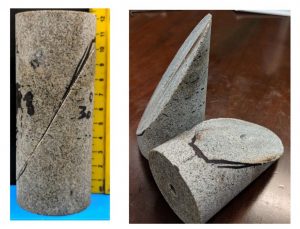A preliminary report by M.H.B. Nasseri and S. Lui
Research objective: Research investigation on understanding of the triggered or induced seismicity have
recently been the focus of many investigators in relation to hydraulic fracturing practice associated with
the unconventional oil and gas production industry in North America. Such projects usually involve
recording and processing of seismic events using axillary bore holes equipped with seismological recording
devices near to the field of interest. Induced seismicity is in association with fluid-injection processes and
elevation of pore pressure affecting pre-existing stable/critically stressed fault systems causing instability
by increasing shear stress leading to fault plane slippage thus creating a man-made earthquake. We are
reporting a preliminary result on simulating the aforementioned phenomena on a saw cut Westerly
granite specimen with bore hole drilled to access the fault plane. The saw-cut fault plane makes an angel
of 30 degrees with respect to the axial stress and the long axis of the cylindrical specimen as shown below.
